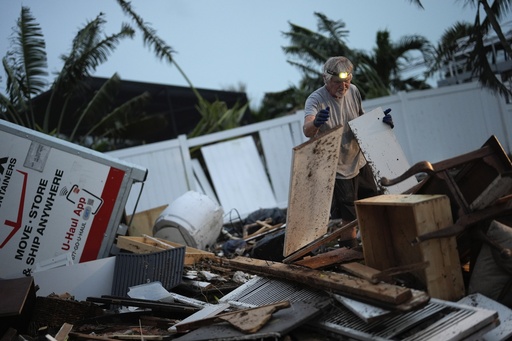WASHINGTON — Federal disaster assistance has become widely available across the United States, with approximately 94% of the American population residing in counties that have received support from the Federal Emergency Management Agency (FEMA) since 2011.
However, disaster aid has turned into a contentious political issue recently, influenced by Hurricane Helene last year and the California wildfires this year. Discussions have emerged from President Donald Trump and a conservative think tank about potentially moving disaster response responsibilities to the states, which could involve reducing federal aid or even dismantling FEMA altogether.
This transition has prompted significant concern among experts. Craig Fugate, who has extensive experience in emergency management in Florida and served as FEMA’s director for President Barack Obama, emphasizes that most states lack the resources to independently handle disasters without federal support. States like Florida would struggle significantly without this financial backing.
Susan Cutter, director of the Hazards Vulnerability & Resilience Institute at the University of South Carolina, adds that most states do not possess the financial capacity to manage large-scale disasters. “They will face serious challenges in dealing with these emergencies without federal assistance,” she asserts.
On the national scale, federal aid plays a crucial role, with every state receiving millions in support; in larger amounts for Republican-controlled states and districts. An atlas created by New York University’s Rebuild By Design has cataloged over 795 disaster events since 2011 not related to health crises or oil spills, revealing that disaster assistance has reached communities across the political spectrum.
Amy Chester, who heads Rebuild By Design, explains that “climate issues affect all states alike, regardless of party affiliation.” She stresses that the fallout from climate-related events touches communities irrespective of their political standing.
Since 2011, FEMA has allocated more than $68.2 billion for disaster recovery, not including pandemic-related impacts or oil spills, and this sum pertains solely to governmental assistance, separate from individual support provided through agencies like Housing and Urban Development.
On average, states led by Republican governors have seen $222 per person in FEMA aid amid 475 federally declared disasters. In contrast, Democratic-led states have accumulated around $193 per person through 320 disasters, signifying a 15% disparity in funding. Swing states that have voted for both Trump and Biden, however, receive significantly less, averaging only $35 per capita, and they account for only 2.5% of total FEMA funding despite housing 15% of the population.
Overall, states that supported Trump in 2024 saw an average of 15% less in FEMA funding than those that backed Kamala Harris, primarily influenced by the lower amounts allocated to the aforementioned swing states. While red states represent 42.7% of the population, they have a disproportionate 56.6% of federally declared disasters while receiving roughly half of the total federal disaster aid. Meanwhile, blue states, making up 42.2% of the population, have 35.8% of the disasters but receive 47.5% of the aid.
Fugate identifies states with frequent disaster declarations as “frequent fliers,” many of which lean Republican. Among the top 15 states in terms of total FEMA funding, spending per capita, and declared disasters, Florida, Louisiana, and Mississippi rank high, indicating a pattern within these regions.
A notable amount of congressional districts—mostly Republican—have experienced a significant number of federally declared disasters since 2011, with districts spread across states like Texas and Kentucky being particularly affected.
According to Cutter, the political dynamics surrounding disaster declarations have evolved over the past few decades. Still, the response protocol remains consistent, requiring states to request federal aid through presidential disaster declarations to enable funding to be disbursed.
Typically, the federal government covers 75% of disaster costs, with states contributing the remaining quarter. In extreme situations, state responsibilities can fall to as low as 10% thanks to congressional interventions. Due to the rapid accumulation of costs during disasters, states often struggle with immediate financial needs, underscoring the importance of timely FEMA assistance.
FEMA also brings specialized skills to disaster recovery efforts, providing crucial support in unique circumstances, like those in California relating to toxic debris from wildfires. Fugate highlights that the agency can swiftly engage entities such as the U.S. Army Corps of Engineers to expedite the clearance process, ultimately benefiting taxpayers.
There are concerns that states, should they assume complete control over disaster response, may face greater challenges in preventing misuse of funds and fraud—issues that are currently managed more effectively under FEMA’s oversight due to strict federal procurement regulations.
“With significant federal involvement, taxpayers contributed to rebuilding the essential infrastructure in Charlotte County after Hurricane Charley in 2004,” Fugate notes, asserting that local authorities could not have coped with such a huge challenge alone.
